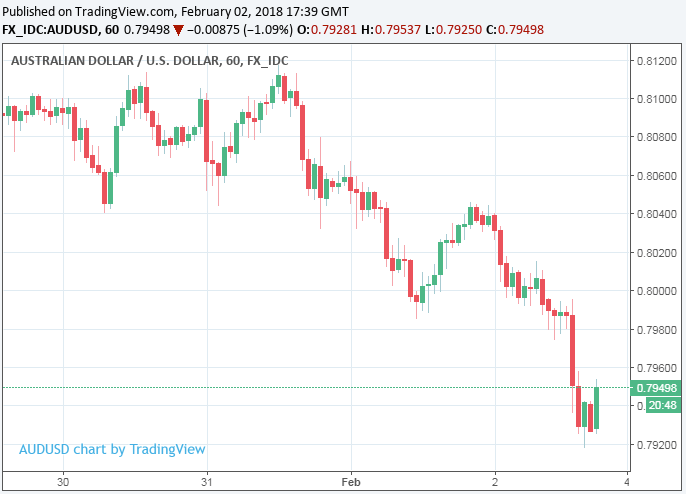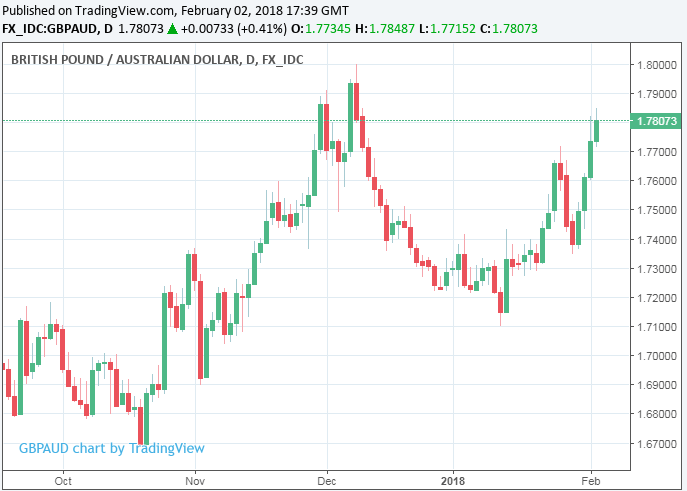Australian Inflation Disappointment is “Not a Game Changer” as RBA is Still Likely to Raise Rates
- Written by: James Skinner
-

© Adobe Stock
Australia’s Dollar could still have its best days ahead of it if BofAML are right and the RBA raises interest rates later on in 2018.
The Australian Dollar fell for a third straight session Friday as traders continued to shun the currency in the wake of Tuesday’s poorer than expected inflation figures.
Both headline and core measures of inflation surprised on the downside for the fourth quarter, with each remaining at 1.9% on an annualised basis, when they had been expected to tick higher by a notch. This is below the midpoint of the Reserve Bank of Australia's 1% to 3% target range.
The disappointment led markets to abandon hope of a hawkish turn in the Reserve Bank of Australia’s rhetoric on the economy and interest rates in Monday’s statement, resulting in the week’s spate of losses.
Such was the disappointment that the Aussie has even spent three days in the red against the US Dollar, which has been under increasing pressure from the remaining G10 basket during much of the past week.
“The message from the 4Q CPI data is that the Reserve Bank of Australia can afford to be patient before moving policy to more normal settings,” says Alexandra Veroude, an economist at Bank of America Merrill Lynch.
“While the data disappointed expectations, the outcome was not a game changer for the RBA outlook. In fact core inflation exceeded the RBA's forecast of 1.75%.”

Above: AUD/USD rate shown at hourly intervals.
Veroude says that, despite core inflation coming in above the RBA’s own forecast, the bank is unlikely to make any changes to its other forecasts that would encourage unwelcome Australian Dollar strength. However, it should still sound an upbeat tone on the economy and future inflation prospects.
“However, we would need to see a clear shift lower in the unemployment rate (which we expect), some traction on wages and perhaps a lower AUD to support our case for a start in the normalization process to begin as soon as May,” Veroude adds.
Bank of America Merrill Lynch has been forecasting an RBA interest rate hike in May 2018, to be followed by another in November 2018, but concedes there are considerable risks to its expectation for this first hike.
That said, the team notes that a steady recovery of inflation and record lows for short term market interest rates means that monetary conditions are about as loose as they’ve ever been in Australian, which means the RBA risks falling behind the inflation curve if it waits for too long before raising rates.
“If the RBA decides to keep rates steady in 2018, then modestly rising core inflation is likely to make conditions even easier (red line) even with the recent appreciation of the AUD,” says Veroude.

Above: Pound-to-Australian-Dollar rate shown at daily intervals.
The Reserve Bank of Australia has held the cash rate steady at a record low of 1.5% for almost 18 months.
This is while pricing in interest rate derivatives markets, which enable investors to protect themselves against changes in rates, currently implies that the RBA will not raise the cash rate before February 2019.
Before now, this hasn’t been such a problem for the Australian Dollar because most other developed world central banks have also kept rates at record lows.
However, the Federal Reserve and Bank of Canada are now firmly committed to hiking cycles while the Bank of England and European Central Bank are also beginning to make policy changes that will increasingly impact upon bond markets.
This means that a negative policy rate spread between Australia and the US looks almost certain in 2018,” says Sally Auld, chief economist for Australia and New Zealand at J.P. Morgan, wrote in a recent currency briefing.
“While rate differentials have seemingly lost some of their pull on currencies of late, we still think that this development should have some influence on the path of AUD/USD."
On the one hand, the closing gap between interest rates in Australian and elsewhere in the world could mean the Australian Dollar is liable to experience a tough time in 2018.
However, with markets not currently expecting a rate rise until early 2019, if Bank of America is right and the RBA does eventually begin to signal that an interest rate rise will come sooner rather than later then things could turn out quite different for the Australian Dollar in 2018.
Advertisement
Get up to 5% more foreign exchange by using a specialist provider to get closer to the real market rate and avoid the gaping spreads charged by your bank when providing currency. Learn more here.










